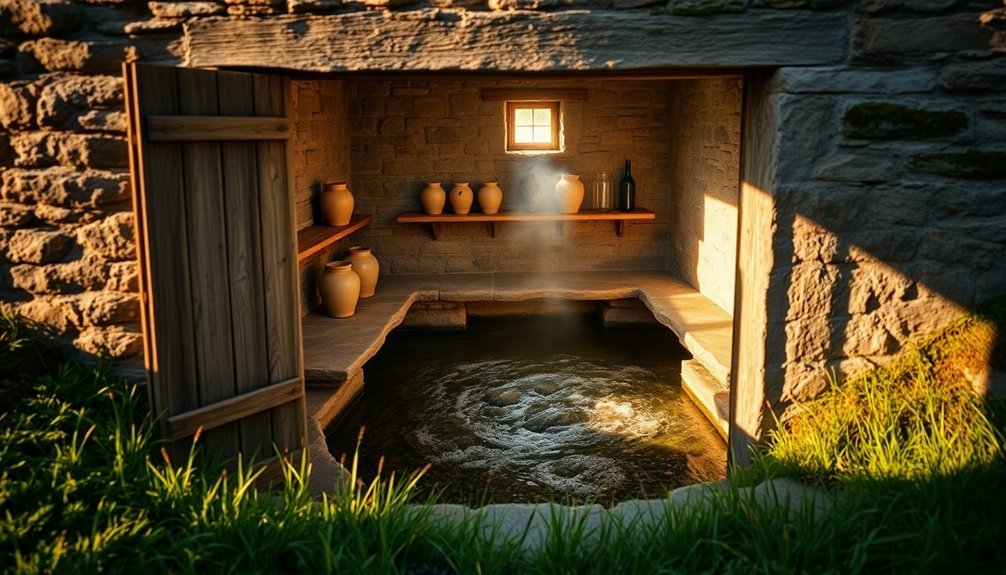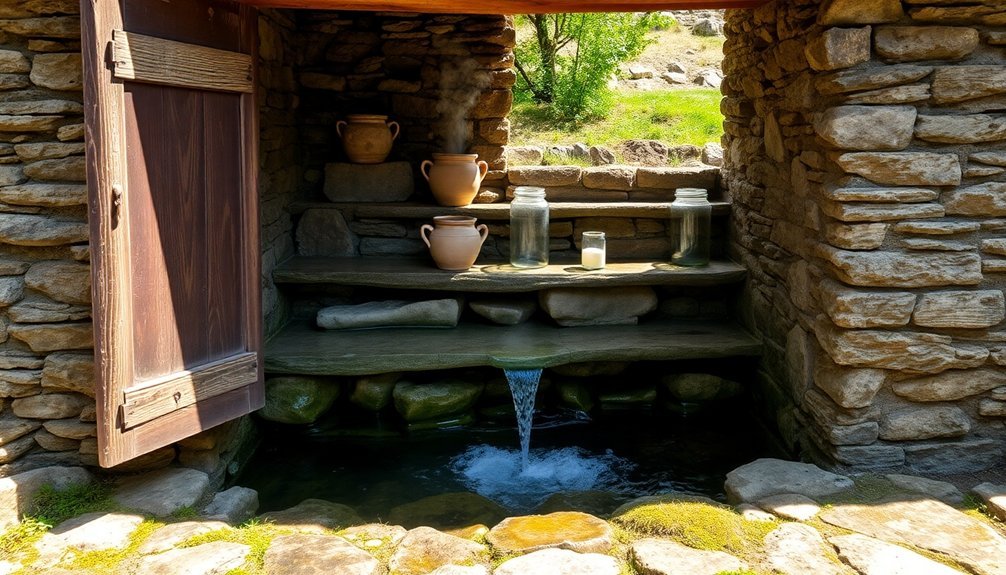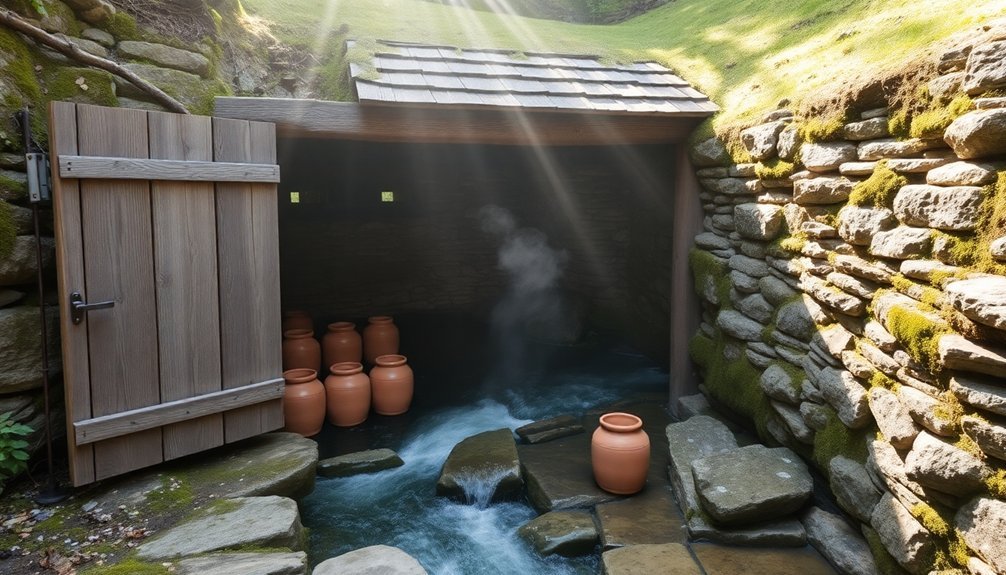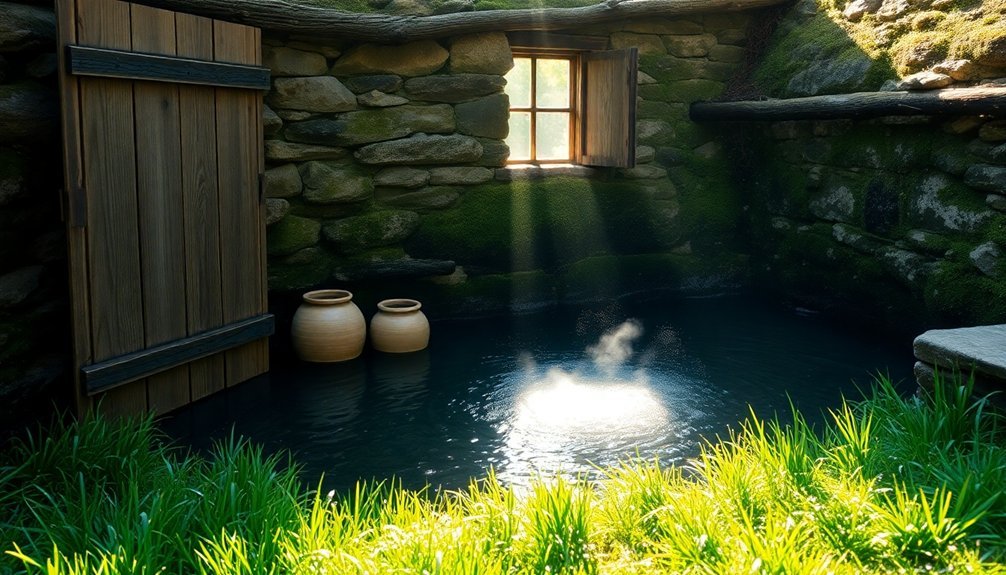Spring houses keep food cold year-round by taking advantage of nature's own cooling system. When you build a thick stone structure around a natural spring, you're tapping into groundwater that maintains a steady temperature in the mid-50s Fahrenheit. The combination of flowing spring water, thermal mass from thick stone walls, and underground or hillside construction creates reliable cooling zones that work in any season. Water channels along the interior walls circulate the cool spring water while preventing contamination, and the multi-level design optimizes storage for different food types. There's much more to discover about these ingenious structures that kept farms self-sufficient for generations.
Natural Cold Water Systems

Natural springs serve as the heart of spring house cooling systems, maintaining a consistent temperature in the mid-50s Fahrenheit year-round. You'll find that this steady temperature creates an ideal environment for storing perishable items, effectively slowing down the food spoilage process without the need for modern refrigeration.
The water management system in spring houses plays an essential role in maintaining these cool temperatures. You'll see how the spring water is carefully directed through channels or small streams within the structure, creating a controlled flow that helps regulate the internal temperature. This flowing water serves multiple purposes: it keeps the environment consistently cool while also preventing contamination from external elements like leaves and animals. Wildlife like salamanders and crayfish can often be found thriving in these spring environments.
When you look at the structural design, you'll notice that spring houses are strategically built directly over or near natural springs, often against hillsides to take advantage of the earth's natural insulating properties.
The continuous supply of clean, cold spring water guarantees that these structures remain effective cooling systems throughout the year, making them invaluable for food preservation in times before electricity.
Underground Construction Benefits
Building underground structures offers significant advantages for preserving food in spring houses. You'll find that underground construction provides natural insulation and temperature regulation, making it highly efficient for food storage. The earth's consistent temperature helps maintain ideal conditions, while the underground location protects your food from external elements and weather fluctuations.
When you build underground, you're tapping into several key benefits. The geothermal mass reduces your energy costs by naturally regulating temperature, and you'll experience fewer disruptions from extreme weather events. Your underground spring house won't be affected by storms, high winds, or flooding that could compromise above-ground structures. The visual appeal of your property improves without exposed utility features above ground.
You're also creating a more sustainable solution, as underground construction minimizes environmental impact and preserves natural habitats.
The construction process itself offers advantages through prefabrication and quality control. You'll save time during installation, and the components are built with higher precision in factory conditions.
Plus, your underground spring house requires minimal maintenance, provides better security against theft or vandalism, and allows for future modifications if needed. This makes it a practical, long-term solution for food preservation.
Thick Stone Wall Design

When building thick stone walls for your spring house, you'll need rocks that are at least double-handful size to guarantee structural integrity and proper temperature control.
Using white mortar and grout between stones ensures maximum stability and insulation. The stones must rest firmly against each other with gravity pulling straight down, creating walls at least 2 feet thick to maximize the natural thermal mass properties.
You'll find that carefully selected and properly installed stonework regulates interior temperatures effectively throughout seasonal changes, making it ideal for food preservation.
Natural Temperature Control Properties
Thick stone walls play an essential role in spring houses' temperature regulation, thanks to their impressive thermal mass properties. You'll find that these walls slowly absorb heat during the day and gradually release it at night, creating a stable interior environment. This process works particularly well in areas with significant day-night temperature swings.
While stone walls aren't great insulators on their own (you'd need a seven-meter-thick wall to meet modern UK building standards), they work effectively when combined with spring water's natural cooling properties. The walls' high density compensates for their poor insulation by delaying heat transfer, which helps maintain consistent temperatures inside the spring house.
The walls' performance depends heavily on proper moisture management. You'll want to verify the stonework includes lime mortar rather than cement-based renders, as this allows the wall to breathe properly. When moisture gets trapped, it reduces the wall's thermal performance.
The integration of spring water with the stone structure creates an ideal environment for food preservation, as the constant flow of cool water works alongside the walls' thermal mass to maintain steady temperatures throughout the year.
Stone Selection and Installation
Selecting the right stones and implementing proper installation techniques form the cornerstone of a successful spring house construction. You'll want to choose stones based on their strength, stability, and natural insulating properties, with limestone and fieldstone being popular choices. These materials maintain consistent temperatures while providing the structural integrity needed for long-term durability.
When building the walls, you'll need to establish a solid foundation using the largest stones in a level trench. As you construct upward, incorporate through stones that span the entire wall thickness to prevent collapse, and fill interior gaps with hearting stones for added stability.
You'll create two parallel faces with a slight inward taper, using the batter frame to maintain the correct slope. For maximum temperature control, you'll want thick walls constructed using the dry-stack method, which allows for natural air circulation between stones.
Top the structure with properly fitted coping stones to protect the wall from water damage. While both mortared and dry-stack techniques work, dry-stack walls typically perform better for spring houses as they allow the natural cooling properties of stone to function more effectively.
Water Flow Management
You'll find that proper water flow management is essential for a spring house's effectiveness in food preservation.
The design requires carefully channeled pathways along interior walls, allowing spring water to circulate naturally throughout the structure while maintaining ideal cooling temperatures.
Managing the water's distribution through these channels helps you maximize the cooling effect while keeping stored food items dry and protected from direct water contact.
Channel Design and Control
Proper channel design and control form the backbone of any effective spring house system. You'll need to select durable materials like stone, cast iron, or PVC for your channels, guaranteeing they're sized correctly to handle your water flow.
When installing pipes, maintain a consistent slope of 1/8" to 1/4" per foot, which prevents water from backing up and guarantees smooth flow.
Your spring box configuration is critical, with inlet pipes positioned above discharge and overflow pipes to prevent back pressure on the spring. You'll want to lay a gravel-filled trench beneath the pipes to maintain proper slope and prevent clogging.
When connecting new pipes to existing ones, use flexible couplings like fernco to create seamless shifts.
Before you start digging, always mark utility lines to avoid damage. You can incorporate French drain systems to manage excess water, using perforated pipes surrounded by gravel.
Make sure your channels run along the inside walls of the spring house, contributing to the overall cooling effect. Regular inspections are essential – you'll need to check for obstructions and maintain unimpeded water flow through your channels.
Natural Flow Distribution
Managing natural water flow in a spring house begins with identifying and exposing the spring source correctly. You'll need to clear vegetation and dig test holes uphill from the seep to locate the impervious layer beneath the water-bearing zone.
Once you've found the source, it's essential to manage the flow distribution properly to maintain consistent cooling temperatures.
To control the water's natural movement, you'll want to dig a 2-foot-wide trench across the slope, extending beyond the seep area. The trench should be 6 inches below the water-bearing layer to capture the flow effectively.
Here are key steps for ideal flow distribution:
- Install a collector pipe at the bottom of the cutoff wall to guide water smoothly into the spring box
- Maintain a consistent slope of 1/8" to 1/4" per foot for proper water movement
- Remove soggy soil around water veins to enhance flow without disrupting natural patterns
- Fill trenches under pipes with gravel to maintain proper slope and prevent settling
- Use Uniseal gaskets for pipe installations to prevent contamination and guarantee proper water levels
This careful management of natural flow guarantees your spring house maintains consistent cooling properties year-round.
Storage Methods and Organization

Efficient storage methods form the backbone of a successful spring house operation. You'll find milk-filled pails and large joints of meat suspended from the rafters, where cool temperatures help maintain their freshness.
The strategic placement of stoneware crocks on built-in shelves and floors maximizes available space while keeping items easily accessible. You can store pickled vegetables, fruits, and corned meats in crocks filled with vinegar or brine. Early onions and garlic, when properly cured, will last for extended periods in airtight containers.
You'll want to dedicate separate sections for different food types to maintain organization and prevent cross-contamination.
If you need additional storage solutions beyond your spring house, you've got several options. You can bury old freezers or refrigerators to create makeshift root cellars, or use trash cans and buckets for root vegetable storage.
For indoor alternatives, you'll find that cardboard boxes with filler materials work well, as do coolers or Rubbermaid totes filled with damp sand. A cool mudroom or north-facing room can serve as an effective supplementary storage space when needed.
Temperature Control Through Architecture
A stone foundation anchors the spring house's temperature control system, working in harmony with natural water sources to maintain consistent cooling.
You'll find these structures built against hills or slopes, where they take full advantage of the earth's natural insulation properties. The stone walls work double-duty, providing structural support while keeping the interior temperature steady in the mid-50s Fahrenheit.
The architectural design maximizes cooling efficiency through several key features that you won't find in typical storage buildings:
- Small channels direct spring water flow throughout the structure
- Minimal openings prevent warm air infiltration
- Single-room design reduces temperature fluctuations
- Stone construction provides natural insulation
- Hill-side placement adds earth-mass cooling
You'll notice that spring houses don't rely on mechanical cooling systems. Instead, they use the constant flow of cool spring water combined with strategic construction methods.
The structure's integration with its environment is particularly clever – it uses shade from surrounding landscapes and the coolness of flowing water to maintain its temperature.
Modern additions like insulated doors can enhance these natural cooling properties, but the basic principle remains unchanged: nature provides all the cooling power needed.
Multi-Level Cooling Zones

Traditional spring houses utilize three distinct cooling zones that work together to maintain ideal food preservation temperatures. Much like modern multi-zone HVAC systems, you'll find that each level serves a specific purpose, with dampers and architectural features controlling the flow of cool air throughout the structure.
You'll notice how the cooling zones work in harmony, similar to today's zoned climate control systems. The spring's cold water enters at the lowest level, creating the coldest zone. As cool air naturally rises, it flows through carefully positioned vents and openings, reaching the middle and upper zones with gradually increasing temperatures.
| Zone Level | Temperature Control | Food Storage Purpose |
|---|---|---|
| Lower | Coldest (water level) | Dairy, meat preservation |
| Middle | Cool (rising air) | Fruits, vegetables |
| Upper | Mild (ambient) | Grains, dried goods |
| Shift | Variable | Air circulation paths |
| External | Warmest | Insulation barrier |
Just as modern HVAC systems use dampers to direct airflow, spring houses employ strategic ventilation points to maintain different temperature zones. You can regulate these zones by adjusting simple wooden vents, allowing precise control over food preservation conditions throughout the structure.
Daily Farm Life Applications
Spring houses consistently serve as the beating heart of daily farm operations, seamlessly integrating food preservation with essential agricultural tasks. You'll find these structures playing multiple roles throughout your day, from storing fresh milk after morning milking to preserving your harvest for future use.
They're particularly valuable when you need to keep dairy products cold or protect large cuts of meat from spoiling. As you go about your daily chores, you'll appreciate how the spring house helps maintain food safety and extends storage life through its natural cooling system.
The constant flow of spring water keeps temperatures steady in the mid-50s, while the stone construction provides additional insulation.
- Store fresh milk in pails immediately after morning and evening milking
- Hang meat joints from ceiling rafters for ideal preservation
- Keep pickled vegetables in stoneware crocks on built-in shelves
- Access preserved fruits and dairy products throughout the day
- Protect food supplies from pests and environmental factors
You can efficiently organize your food storage by using the spring house's built-in features, from shelving to hanging spaces, making it easier to manage your farm's food preservation needs while maintaining a smooth workflow in your daily routine.
Historical Preservation Techniques

You'll find that historic spring houses maintained their vital role in food preservation through ingenious natural cooling methods that utilized flowing spring water to keep perishables fresh.
These structures remained essential to farm life well into the 20th century, adapting and evolving with the changing needs of agricultural communities.
Through careful restoration and documentation, many surviving spring houses continue to demonstrate the resourceful storage techniques that farmers once relied upon to preserve dairy products, fruits, and vegetables.
Natural Cooling Methods Preserved
Throughout history, our ancestors relied on ingenious methods to preserve their food without modern refrigeration. They discovered that spring houses, built near natural water sources, could maintain consistently cool temperatures year-round.
You'll find that these structures weren't just simple buildings – they were carefully designed cooling systems that utilized flowing water and natural insulation.
Before mechanical refrigeration, people preserved their food using several effective methods in conjunction with spring houses. Here are the key preservation techniques they employed:
- Storing dairy and meat products in cool streams running through spring houses
- Burying food in snow or ice when available for freezing
- Using fermentation and pickling to create environments hostile to bacteria
- Curing meats with salt and storing them in cool spring house environments
- Preserving fruits and vegetables through sugaring methods
When you examine these historical techniques, you'll notice they often worked together.
For instance, pickled vegetables stored in a spring house would last even longer than those kept at room temperature. The combination of preservation methods and the natural cooling provided by spring houses created an effective system that kept food safe and edible for extended periods.
Farm Storage Through Time
Farmers' ingenuity in preserving food has evolved dramatically since ancient times, with several key methods standing the test of time.
You'll find that drying was one of the earliest techniques, dating back to 12,000 B.C., when Middle Eastern and Oriental cultures used sun and wind to preserve their harvest. When natural elements weren't sufficient, they'd build "still houses" heated by fire to dry fruits, vegetables, and herbs.
As farming practices advanced, you'd see the widespread adoption of curing and salting, especially for meat preservation. Farmers would rub salt on meat and create brines in wooden barrels, ensuring their protein sources lasted through lean times.
They'd also embrace fermentation and pickling, transforming ordinary vegetables into long-lasting, nutritious foods like sauerkraut.
In colder regions, you'd notice farmers taking advantage of natural freezing by burying food in snow or ice. They'd construct icehouses to store their harvests and use cool cellars or caves when available.
This practice continued until the 1800s when mechanical refrigeration revolutionized food storage, leading to more reliable preservation methods that we still use today.
Seasonal Temperature Consistency
The steadfast temperature within a spring house stands as one of its most remarkable features. You'll find that these structures maintain a consistent mid-50°F range throughout the year, making them perfect for food preservation. The spring's natural flow of cool water, combined with strategic construction into hillsides, creates an efficient cooling system that doesn't require any external power.
When you examine a spring house's construction, you'll notice how it maximizes temperature stability through several key features:
- Stone walls that slowly absorb and release heat
- Natural hillside insulation that blocks external temperature changes
- Controlled water channels that enhance cooling efficiency
- Earth-contact design that regulates internal conditions
- Strategic placement away from direct sunlight
You won't need to worry about seasonal changes affecting your stored goods, as the spring house's design naturally counters external temperature fluctuations.
The combination of flowing water and thermal mass creates a reliable environment for preserving perishables year-round. Whether it's the height of summer or depth of winter, you can count on your spring house to maintain its cooling effectiveness through purely natural means.
Frequently Asked Questions
How Many Days Can Meat Stay Fresh in a Spring House?
You can keep raw meat fresh for 1-2 days in a springhouse, where temperatures stay around 50°F. While it's not as effective as modern refrigeration, you'll get similar storage time as a refrigerator.
Can Spring Houses Be Built in Areas Without Natural Springs?
Yes, you can build a spring house without a natural spring by using alternative water sources like creeks or diverted streams. You'll need to design channels and pipes to direct water flow effectively for cooling.
What Happens to Spring Houses During Drought Conditions?
During droughts, you'll notice your spring house's cooling ability weakens as water flow decreases. You'll see higher temperatures inside, compromised food storage, and you might need to find alternative cooling methods or water sources.
Did Native Americans Use Spring Houses Before European Settlers Arrived?
No, you won't find evidence of Native Americans using spring houses before European settlers arrived. They relied on different methods like underground caches and natural cooling environments to store and preserve their food.
How Does Winter Freezing Affect Spring House Water Flow?
You'll find that winter freezing doesn't greatly impact spring house water flow because it's protected underground. The aquifer's constant temperature and movement keeps water flowing, while the structure provides additional insulation against freezing.
In Summary
You'll find that spring houses are marvels of natural refrigeration, combining flowing spring water, underground construction, and thick stone walls to maintain consistent temperatures year-round. Whether you're storing milk, butter, or vegetables, these structures harness the earth's natural cooling properties. By understanding how spring houses work, you'll appreciate this sustainable, energy-free method that's kept food fresh for generations.





Leave a Reply